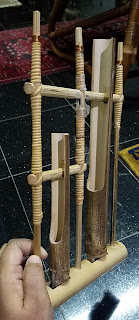Had the good fortune of meeting Dr Anasuya Kulkarni, a doyenne of world music.
Having lived in multiple countries in the South East and Africa, Dr Kulkarni has not only mastered the local instruments of those countries, but also adapted them for use in classical Carnatic concerts. She graciously organized and performed an impromptu private concert for me in her beautiful home in J.P. Nagar, Bengaluru. M'am, I'm so honoured to have met you today and will treasure this angklung performance you and your students treated me to.
Here are some video clips of tonight's impromptu angklung concert. The first is a Carnatic tillana. The second is a popular Indonesian song Halo-Halo Bandung.
The angklungs in these videos are unlike those traditionally used in Indonesia. Traditional Indonesian angklung performances feature multiple musicians and is led by a conductor, since each artist plays 1-2 notes only.
Dr Kulkarni is the first to adapt and introduce the anghlung to the Carnatic music scene. Hear her explain it in herself Kannada. Her idea was to make the instrument playable by just one person and make it easy for that artist to handle their instrument. Through her innovation, she set angklungs of different notes in a wooden frame, making it convenient for a single artist to perform a full piece using all the notes. Dr Anasuya's first public performance with the angklung was at the Durlabha Vadya Vinod International Music Festival in 1982.
 |
| In 2008, Limca Book of Records awarded Dr Anasuya for introducing the angklung to Carnatic music |
The frame can hold 8 angklungs at most. For a raga that uses different notes, the artist picks the angklungs with those notes and changes the array on the wooden frame. But what if you need a note in a higher octave? Since each angklung produces notes in 2 octaves, the same anklung is used for both the ordinary and the higher note.
Enjoy these clips from her recent concert with a full Carnatic ensemble, supported by Vidwan Yashaswi on violin, Vidwan B.N. Ramesh on mridangam and A.V. Kashinath on kanjira, accompanied by her students Tapasya Singh (left) & Jahnavi Singh (right) : Vatapi Ganapatim Bhaje and Thyagaraja's Pancharatna Kriti Endaro Mahanubhavulu









